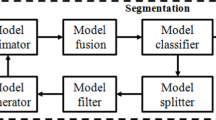Abstract
In this paper we address the problem of detecting objects from a moving camera by jointly considering low-level image features and high-level object information. The proposed method partitions an image sequence into independently moving regions with similar 3-dimensional (3D) motion and distance to the observer. In the recognition stage, category-specific information is integrated into the partitioning process. An object category is represented by a set of descriptors expressing the local appearance of salient object parts. To account for the geometric relationships among object parts, a structural prior over part configurations is designed. This prior structure expresses the spatial dependencies of object parts observed in a training data set. To achieve global consistency in the recognition process, information about the scene is extracted from the entire image based on a set of global image features. These features are used to predict the scene context of the image from which characteristic spatial distributions and properties of an object category are derived. The scene context helps to resolve local ambiguities and achieves locally and globally consistent image segmentation. Segmentation results are presented based on real image sequences.
Access this chapter
Tax calculation will be finalised at checkout
Purchases are for personal use only
Preview
Unable to display preview. Download preview PDF.
Similar content being viewed by others
References
Bachmann, A.: Applying recursive EM to scene segmentation. In: Deutsche Arbeitsgemeinschaft fuer Mustererkennung DAGM e.V., Jena, Germany (September 2009)
Bachmann, A., Balthasar, M.: Context-aware object priors. In: IEEE IROS 2008; Workshop on Planning, Perception and Navigation for Intelligent Vehicles (PPNIV), Nice, France (2008)
Bachmann, A., Dang, T.: Improving motion-based object detection by incorporating object-specific knowledge. International Journal of Intelligent Information and Database Systems (IJIIDS) 2(2), 258–276 (2008)
Besag, J.: Spatial interaction and the statistical analysis of lattice systems. Journal of the Royal Statistical Society Series B 36(2), 192–236 (1974)
Burl, M.C., Weber, M., Perona, P.: A probabilistic approach to object recognition using local photometry and global geometry. In: Burkhardt, H., Neumann, B. (eds.) ECCV 1998. LNCS, vol. 1407, p. 628. Springer, Heidelberg (1998)
Crandall, D., Huttenlocher, D.: Composite models of objects and scenes for category recognition. In: Proc. IEEE Conference on Computer Vision and Pattern Recognition, CVPR 2007, pp. 1–8 (2007)
Dang, T., Hoffmann, C., Stiller, C.: Self-calibration for active automotive stereo vision. In: Proceedings of the IEEE Intelligent Vehicles Symposium, Tokyo (2006)
Duchow, C., Hummel, B., Bachmann, A., Yang, Z., Stiller, C.: Akquisition, Repraesentation und Nutzung von Wissen in der Fahrerassistenz. In: Informationsfusion in der Mess- und Regelungstechnik 2006, VDI/VDE-GMA, Eisenach, Germany (2006)
Fischler, M., Elschlager, R.: The representation and matching of pictorial structures. IEEE Trans. Comput. 22(1), 67–92 (1973)
Geman, S., Geman, D.: Stochstic relaxation, Gibbs distribution, and the Bayesian restoration of images. IEEE Transaction on Pattern Analysis and Machine Intelligence 6, 721–741 (1984)
Harris, C., Stephens, M.: A combined corner and edge detector. In: Fourth Alvey Vision Conference, Manchester, pp. 147–151 (1988)
He, X., Yung, N.: Curvature scale space corner detector with adaptive threshold and dynamic region of support. In: 17th International Conference on Pattern Recognition, Washington, DC, USA, vol. 2, pp. 791–794. IEEE Computer Society, Los Alamitos (2004)
Ohm, J.-R., Ma, P.: Feature-Based cluster segmentation of image sequences. In: ICIP 1997, Washington, DC, USA, vol. 3, pp. 178–181. IEEE Computer Society, Los Alamitos (1997)
Rentschler, I., Juettner, M., Osmana, E., Mueller, A., Caell, T.: Development of configural 3D object recognition. Elsevier - Behavioural Brain Research 149(149), 107–111 (2004)
Rockwell, T.: Skills, judgment, and information acquisition in driving. Human Factors in Highway Traffic Safety Research, 133–164 (1972)
Sivak, M.: The information that drivers use: is it indeed 90% visual? Perception 25(9), 1081–1089 (1996)
Author information
Authors and Affiliations
Editor information
Editors and Affiliations
Rights and permissions
Copyright information
© 2010 Springer-Verlag Berlin Heidelberg
About this paper
Cite this paper
Bachmann, A., Lulcheva, I. (2010). Scene Segmentation from 3D Motion and Category-Specific Information. In: Ranchordas, A., Pereira, J.M., Araújo, H.J., Tavares, J.M.R.S. (eds) Computer Vision, Imaging and Computer Graphics. Theory and Applications. VISIGRAPP 2009. Communications in Computer and Information Science, vol 68. Springer, Berlin, Heidelberg. https://doi.org/10.1007/978-3-642-11840-1_13
Download citation
DOI: https://doi.org/10.1007/978-3-642-11840-1_13
Publisher Name: Springer, Berlin, Heidelberg
Print ISBN: 978-3-642-11839-5
Online ISBN: 978-3-642-11840-1
eBook Packages: Computer ScienceComputer Science (R0)




